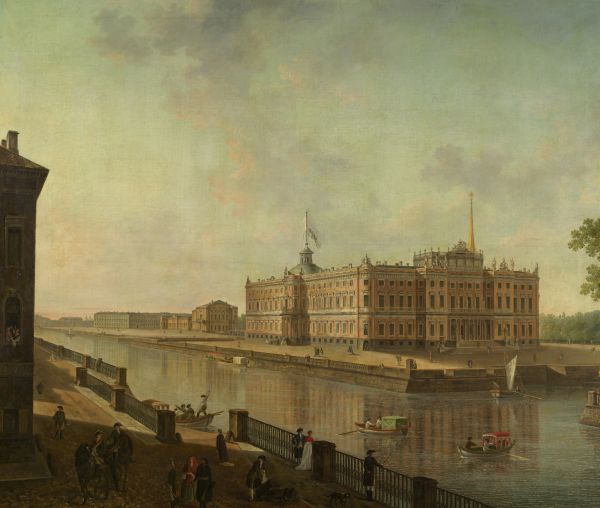|
|
View onto St. Michael’s Castle in Saint Petersburg from the Fontanka Side

Alexeyev Fyodor,
Oil on canvas
156 х 185
State Russian Museum
Annotation
The construction of the castle was implemented under the supervision of an architect with Italian origin – Vincenzo Brenna; he designed the original project of the palace and its interiors.
A singular appearance of the castle, combining contradictory architectural tendencies and stylistic means, distinguishes it from the general Russian classicism. Yet it is the castle that is often considered as a symbol of Paul’s epoch. Its image absorbed artistic tastes and distinctness of its owner and main creator – emperor Paul I. The majestic giant – the St. Michael’s Castle, as it was called in documents of the 18th century – overlooked the island, washed by waters of Moyka and Fontanka rivers from north and east. The walls of the palace are adorned with columns of pink and grey marble. Initially marble statues were installed on the roof. From the western side a palace church of Archangel Michael, the patron saint of Romanovs, is located – its spire is the most important element of the whole ensemble.
The painting was created on the order of emperor Paul I for the St. Michael’s Castle.
Author's Biography
Alexeyev Fyodor
Alexeyev, Fyodor Yakovlevich
1753/1754 (?). St Petersburg - 1824, St Petersburg
Painter, founding father of the Russian school of urbanscape painting. Son of a guard at the Imperial Academy of Arts. Studied fruit and flower and landscape painting at the Imperial Academy of Arts (1766-73). Awarded a fellowship to Venice (1773-77). Studied under Giuseppe Moretti and Pietro Gaspari. Returned to St Petersburg and worked as a painter for the Imperial Theatres (1799). Copied paintings by Canaletto and Bernardo Bellotto for Catherine the Great. Nominated to the Academy (1794). Sketched places visited by Catherine the Great (1787) in south Russia (1795). Painted urbanscapes in Moscow (1800). Councillor of the Imperial Academy of Arts (1802), Taught perspective painting at the Imperial Academy of Arts (1803-24).

